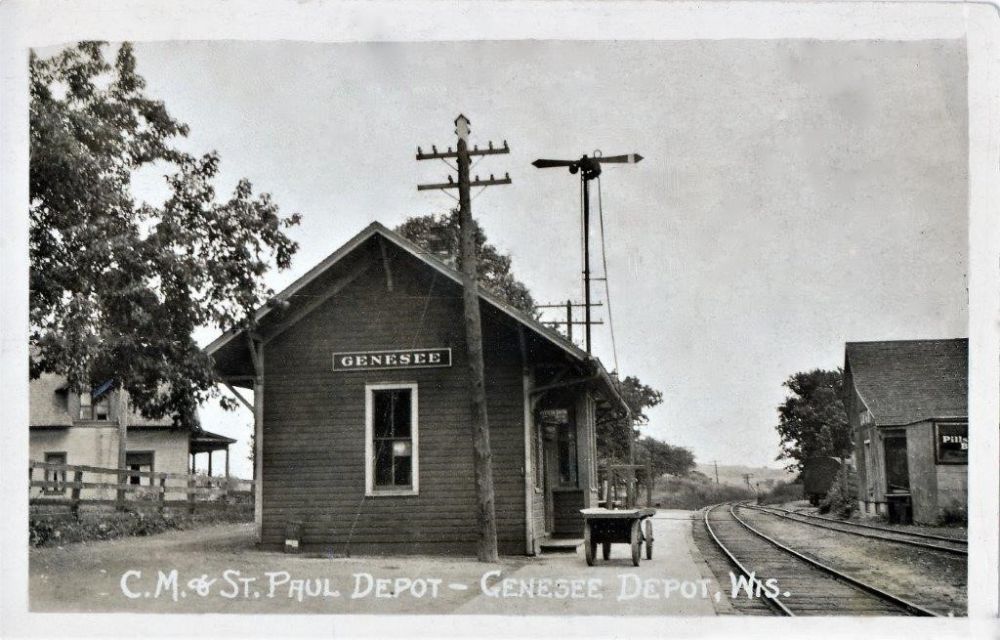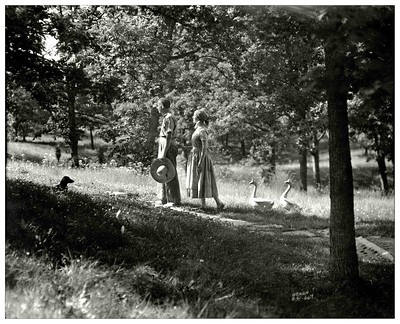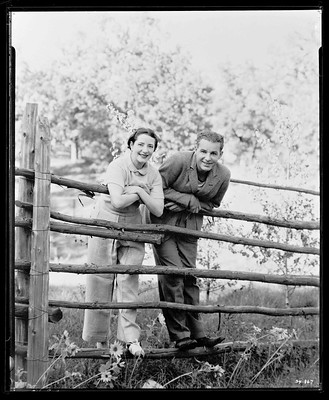History of Genesee
A brief History
Township of Genesee, WI
Genesee Township is located near the center of Waukesha County (between Waukesha & Ottawa) in the beautiful “Kettle Moraine” area of southeast Wisconsin. The area was founded by German, Welsh, Irish, and English immigrants in the early 1840’s. The Wisconsin state Legislature approved the present town boundaries of Genesee on March 21, 1843.
The entire area was formed 10,000 years ago by the glaciers. Now its terrain is very hilly and its soil is shallow. Beds of gravel & limestone underlie the land surface.
One fact that made Genesee unique is the number of independent settlements in the township. There were 5 separate trading centers (Genesee Village, Saylesville, Genesee Depot, North Prairie , and Wales) created by roads, railroads, and waterpower.
Genesee Village(North Genesee)
Genesee Village is located one-quarter mile south of Hwy 59 on Hwy 83. Settlement in the Genesee Village area (North Genesee) was in 1837 with Stillman Smith deciding to live in the district in the spring of that year. In the summer he and his brother Horace built a house. In 1838, following the construction of a territorial road, Benjamin A. Jenkins built the first inn which was called “Jenkins’ Log Cabin” at old Hwy 59 (Old Village Road) and Hwy 83. The place was called Jenkinsville and the establishment served travelers going between Milwaukee, Waukesha, and Janesville. Caravans carrying lead from southwest Wisconsin to Milwaukee also patronized the inn. Jenkins also built a three-story mill in 1840 and a few years later erected a wagon factory. He even gave land away to induce settlers to come to North Genesee. By the 1850’s there was a foundry, meat packing plant, two blacksmith shops, shoe shop, gristmill, store, millinery shop, church, school, and woolen mill.
Saylesville (South Genesee)
Indian trails were described as being 20 inches wide and 3-4 inches deep. Along one of these trails that ran from Milwaukee to Mukwonago, 8 miles southwest of Waukesha, Alexander Rankin and his wife built a log cabin to become the first settlers of Saylesville (1837). This log cabin site is located just a few rods east of the present Rankin-Booth House, (S57 W29687 Saylesville Road), which is listed on the National Register of Historical Places. The Rankin-Booth House, (a.k.a. the “Booth House” as it was owned by J.C. Booth and his descendent from 1930 to the present time) was erected between 1850 and 1852 with rock mined from Johnston’s Quarry. Charles Smith, a stone mason, who did the stonework of the first mill dam, put up the walls. After Mr. Rankin died, Smith married his widow. Their son Leslie S. Smith was born there and kept the farm in the family for 65 years. Although Alexander Rankin was the first settler, Saylesville was named after Stephen Sayles and his four sons, Whitman, Mortimer, Dan and George, who arrived in 1839. After building cabins of their own the Sayles brothers continued to build the settlement. Whitman Sayles helped to dam the creek to form Saylesville Pond, and built a mill by 1841 (first a flour mill and then a grist mill). Whitman and Mortimer Sayles built the first creamery and store in 1842, and George ran the first general store. Stephen Sayles gave land for the cemetery and by 1847 a school was built across from the cemetery. By 1849 a blacksmith shop was set up by William Brown and the community hall was added in 1878. By 1900, Saylesville included the cemetery, a blacksmith shop, a mill, Pitcher’s Store with dance and poolroom in rear, a cobbler shop, the community hall, and the creamery.
Johnston Quarry
One mile north of Saylesville on Hwy 59 is the site of the Johnston Quarry, established in 1842. The quarry was bought from Silas Remington by William Johnston and Thomas Cook and provided stone for many buildings including the state capitol at Madison, the Waukesha Methodist Church and some of Carroll College’s early buildings (Waukesha), and the Milwaukee Sentinel building. Hand carved rock from Johnston’s Quarry also marked the graves of early pioneers. Today the quarry is no longer in operation but the property is listed on the National Register of Historical Places.

Genesee Depot
Genesee Depot was settled predominantly by the English, Irish & Welsh and became a thriving settlement when the Milwaukee & Mississippi Railroad laid tracks through the area in 1851. Settler John Magee (whom the local elementary school is named after) was instrumental in bringing the rail service to Genesee Depot after it was originally planned for the community of Genesee Village, but the asking price for land there was considered too high. Townspeople needed shipping facilities and once the rail service began, Genesee Depot became a “boom-town” of commercial activity, an agricultural service center, and caused Genesee Village to decline. In 1861 Patrick Lynch, a 35-year-old Irish immigrant, built the Union House Hotel, which maintained a prominent position within Genesee Depot. The establishment, operating today as a wine shoppe and restaurant for fine dining, was open to village residents and visitors from Chicago and Milwaukee who wanted to spend time relaxing and enjoying the healthful spring waters in the area. The hotel was built in the 19TH century’s fashionable Greek Revival architectural style and was the largest public building in the Depot. The second floor served as a ballroom and also functioned as a social gathering place.By 1862, Benjamin Jenkins built a general store and warehouse and the post office also then moved. The growing area became known as Genesee Depot, and with many nearby dairy farms (see Bethesda Area) it became one of the largest milk shipping points in the nation, transporting 2-3 carloads of milk daily to Chicago, Milwaukee, and other points until 1908. By the 1890’s there was a grain elevator, slaughter house, two stores, blacksmith shop, shoe shop, woolen factory, post office, lumber yard, and train depot with ticket, baggage, and waiting rooms, storage buildings, and a platform where many went off to high school and Carroll College in Waukesha. Many of the buildings standing today in Genesee Depot date back to the 1800’s and help the area retain the charm of that earlier period, including the original section of St. Paul’s Catholic Church (Hwy 83 & D), built in the early 1870’s; the James Proctor House (Hwy 83 by bridge spanning Genesee Creek) also dating back to the 1860’s, behind which stood the Genesee Woolen Mill; and the new railroad depot built in 1897 after the first one burned down. This station building was relocated slightly south of where it originally stood on Hwy 83 and serves diners today as the Genesee Depot Cafe. The Cafe interior walls are decorated with historical photographs and memorabilia showing earlier times and people.
Genesee’s original Town Hall, located on Hwy 83, was built in 1912 and is listed on the National Register of Historic Places. Genesee Depot is also the home of Ten Chimney’s, former residence of America’s most noted first couple of Broadway Theater, Alfred Lunt and Lynn Fontanne.
Wales-Genesee Lions Club Building(original Town Hall)
The original Town Hall was built in 1912 and was located at S42 W31400 Hwy 83 in Genesee Depot. The building is now the home of the Wales-Genesee Lions & Lioness Club’s. It is listed on the National Register of Historic Places.


.jpg)
Ten Chimneys (home of Alfred Lunt & Lynn Fontanne)
Ten Chimneys was the home of theater greats Alfred Lunt and Lynn Fontanne. Located on Depot Rd. in Genesee Depot, Ten Chimneys is on the National Register of Historic places. The Ten Chimneys Foundation was formed to preserve & restore the estate of Alfred Lunt & Lynn Fontanne. The National Advisory Board includes such luminaries as Hume Cronyn, Anna Crouse, Uta Hagen, Julie Harris, Hal Holbrook, Celeste Holm and Robert Whitehead, and the list of board members is continuing to grow. For more information or to become involved in the wide variety of volunteer activities, call Nellie Martens at (262) 968-4161.
North Prairie
North Prairie is located about 3 miles west of Genesee and Genesee Depot near Hwy 59 and Hwy E. Three men from Mukwonago, who were on a prospecting tour, named the town in 1826. The first settlers were Mr. Denny and Chas. Raynaus, blacksmiths from Eagle, who arrived in 1837. The first claim was by Stillman Smith, the first settler of Genesee Village. Raynaus started the first school in 1840 in his house. There was a store and post office by 1850 and the Milwaukee & Mississippi Railroad in 1851. North Prairie became one of the region’s important commercial and residential centers. In 1866 a rumor about oil started the North Prairie Petroleum Company with $50,000 “to dig a hole & extract oil or minerals.” It was a failure. In 1877 St. John’s Lutheran Church was built and still stands today. Around 1920 when some communities were beginning to decline, North Prairie experienced a growth due to the Morey Milk Condensery, which opened in 1917. The plant was sold in 1924, employed more than 200 people and supported more than 85% of the families. The plant is no longer in existence. North Prairie incorporated in 1919 as a separate government entity.
Wales
Welsh immigrants traveled to the area in the early 1840’s. By 1842 there were 99 residents and by 1871 Wales had seven church societies. Mr. Elias, an early settler, deeded land for a village with the provision that if ever a tavern were opened, the land would revert back to his family. At what is now the intersection of Hwy 18 and 83, a post office was built and the area was called “Enos.” The railroad came through in 1881-82 and the post office was moved to what officially became known as Wales. The first great singer, John P. Jones, came about 1845 and many singing schools were opened. In 1875 a great Gymanfa Gana (songfest) started. Many of the singers achieved national recognition. Wales was incorporated as a separate government entity in 1922.
Bethesda Area
The Bethesda Presbyterian Church, located in northeast Genesee (Hwy DE and Bethesda Church Road), was organized in 1845 and the present church built in 1877. The area pioneered in sanitary milk. Mr. and Mrs. John Williams (Park Farms) were the first and in 1903 completed plans for the organization of the Guernsey Breed Association along with Rich. W. Rowlands (Keystone Farm). The emphasis was on clean, sanitary conditions for milk production. After passing strict health and TB tests, they shipped milk to Milwaukee and Chicago. Park and Keystone Farms could not supply the demand so arranged with D.L. Williams (Wern Farm) and Howard Greene (Brook Hill Farm), to produce certified milk and so this area became well known for its dairy farms. By 1917 the largest certified milk farm in the United States was Robert G. Morey’s Pleasant Valley Farm in Genesee. So Genesee not only had the first, but the largest.
Saylesville Historic District
Saylesville Road from Genesee Creek to Point Drive, in the Town of Genesee, has been entered in the National Register by the Secretary of the Interior, and listed in the State Register of Historic Places, by the State Historic Preservation Officer. Accordingly, this property is entitled to the benefits and protections of the national historic preservation act of 1966, as amended and under chapter 44, Wisconsin statutes. It will receive limited protection from encroachment by federal or state assisted or licensed projects or state facilities development projects, and may be eligible to apply for matching grants for research, restoration, acquisition, or stabilization. Certain tax incentives are available to depreciable properties listed in the State Register for National Register.In the State Register and National Register, programs are administered by the Division of Historic Preservation of the Wisconsin Historical Society, Alicia Goehring, State Historic Preservation Officer. Questions about the State Register and the National Register programs in Wisconsin should be addressed to:
Division of Historic Preservation
Wisconsin Historical Society
816 State Street
Madison, WI 53706
Telephone: 608/264-6500
The above information has been received and filed at the Genesee Town Hall on April 23, 2003.
Special thanks to the Genesee Heritage Society for compiling the information contained in this history page.
Genesee Heritage Society
P.O. Box 52
Genesee Depot, WI 53127
Rosemary Booth, (262) 968-3486
The Genesee Heritage Society serves the areas of:
Genesee, North Prairie, Saylesville, and Wales.
Affiliate - State Historical Society of Wisconsin - Wisconsin Council for Local History
Members of Genesee Heritage Society:
Drake Reid, President
Sharon Moran, Vice President
Evelyn Reid, Treasurer
Rosemary Booth, Secretary
Sharon Leair
Kelly Moran
Merle Teske
Bob Uchner
New members are always welcome to join the Genesee Heritage Society. Meetings are held the third Wednesday of each month (subject to change) @ the Genesee Town Hall. For further information contact Rosemary Booth at (262) 968-3486.
